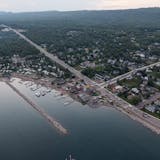For two years in a row, a map proclaiming the favorite Thanksgiving pies of various regions of the United States has delighted, riled and flummoxed millions of Twitter users.
Pecan pie, a known favorite of the southern states where pecan trees actually grow, is attributed to a cluster of Northeastern states. Texas inexplicably gets key lime pie. And the beleaguered Midwest – still weary and shaken from the infamous Minnesota Grape Salad debacle of 2014 – is somehow pegged as the land of Coconut Cream Pie. Minnesotans collectively wailed: Have we not suffered enough?
If it smacks of tomfoolery, it's because the map is a joke. An intentionally absurd, thoughtfully crafted fake.
Last year, Brian Brettschneider, a climate scientist and geographer in Alaska, set out to parody the viral maps he's seen circulate on social media in recent years: maps of dubious methodology that chart the most popular Halloween candy or Thanksgiving side dishes for each state. Brettschneider creates maps for his work – "actual science," he clarified – but he also plays around some for his Twitter followers.
"I would make a map of a winter forecast and it would just say "cold" everywhere. I would make a mosquito forecast with a thousand mosquitoes all over a map. I'm known for making absurd maps like that so I thought, I'll make an absurd Thanksgiving pie map."
He drew nonsensical regional boundaries and picked the most ridiculous pies he could think of – blackberry, coconut cream – intentionally leaving off the most popular Thanksgiving flavors, pumpkin and apple.
"That was my cue that it was not to be taken seriously," he said. "Pumpkin and apple weren't even on there."
The cue went unheeded.


